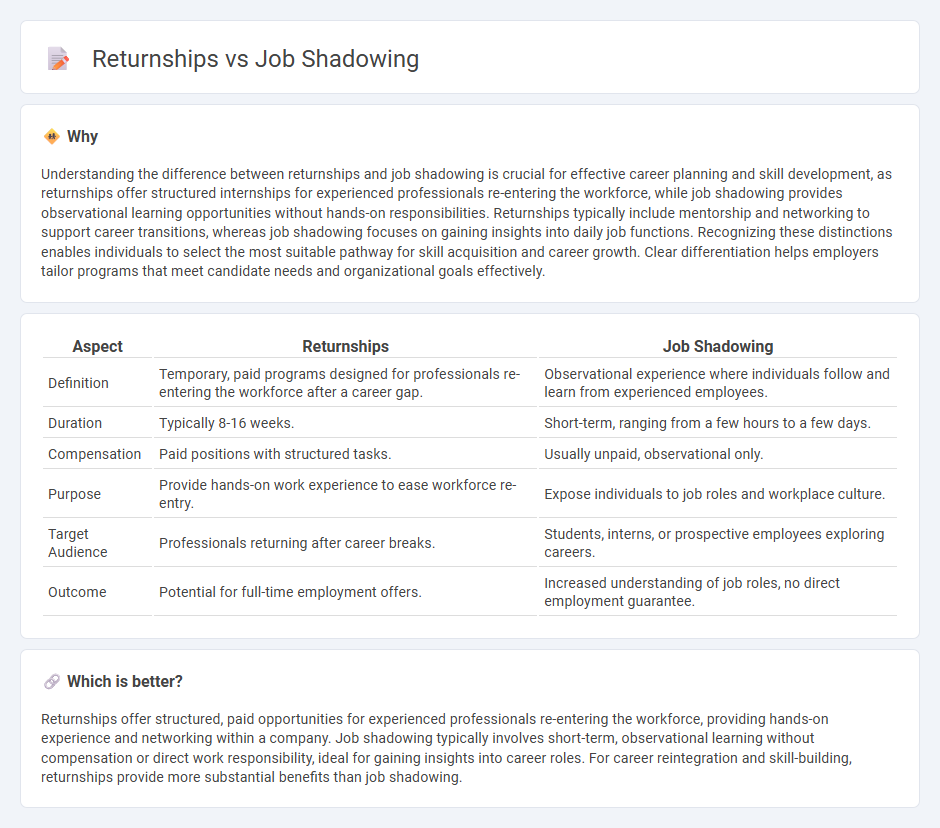
Returnships offer experienced professionals temporary roles to transition back into employment with hands-on project involvement and networking opportunities. Job shadowing provides brief observational experiences, enabling individuals to understand daily job functions without direct task responsibilities. Discover how these pathways can uniquely support your career growth and job readiness.
Why it is important
Understanding the difference between returnships and job shadowing is crucial for effective career planning and skill development, as returnships offer structured internships for experienced professionals re-entering the workforce, while job shadowing provides observational learning opportunities without hands-on responsibilities. Returnships typically include mentorship and networking to support career transitions, whereas job shadowing focuses on gaining insights into daily job functions. Recognizing these distinctions enables individuals to select the most suitable pathway for skill acquisition and career growth. Clear differentiation helps employers tailor programs that meet candidate needs and organizational goals effectively.
Comparison Table
| Aspect | Returnships | Job Shadowing |
|---|---|---|
| Definition | Temporary, paid programs designed for professionals re-entering the workforce after a career gap. | Observational experience where individuals follow and learn from experienced employees. |
| Duration | Typically 8-16 weeks. | Short-term, ranging from a few hours to a few days. |
| Compensation | Paid positions with structured tasks. | Usually unpaid, observational only. |
| Purpose | Provide hands-on work experience to ease workforce re-entry. | Expose individuals to job roles and workplace culture. |
| Target Audience | Professionals returning after career breaks. | Students, interns, or prospective employees exploring careers. |
| Outcome | Potential for full-time employment offers. | Increased understanding of job roles, no direct employment guarantee. |
Which is better?
Returnships offer structured, paid opportunities for experienced professionals re-entering the workforce, providing hands-on experience and networking within a company. Job shadowing typically involves short-term, observational learning without compensation or direct work responsibility, ideal for gaining insights into career roles. For career reintegration and skill-building, returnships provide more substantial benefits than job shadowing.
Connection
Returnships and job shadowing both provide structured pathways for individuals to re-enter the workforce or explore new career fields by gaining practical experience. Returnships are often designed as temporary, paid programs specifically targeting professionals resuming their careers after a hiatus, while job shadowing offers short-term observational opportunities to learn about day-to-day job responsibilities and workplace culture. These approaches enhance employability by building relevant skills, expanding professional networks, and increasing confidence in the targeted employment sectors.
Key Terms
Mentorship
Job shadowing offers direct observation and learning opportunities under the guidance of experienced professionals, fostering real-time skill acquisition and workplace integration. Returnships provide structured mentorship programs designed for career re-entry, emphasizing skill redevelopment and confidence building through hands-on projects and personalized support. Explore our detailed comparison to understand which mentorship approach best accelerates your career growth.
Skill Development
Job shadowing offers real-time observation of professionals, enhancing practical understanding and immediate skill acquisition in various roles. Returnships provide structured training programs for career returnees, emphasizing skill rebuilding and professional growth through mentorship and hands-on projects. Explore more to discover which pathway best boosts your career skills effectively.
Transition
Job shadowing offers immersive, short-term exposure to workplace roles, enabling transitions into new careers by observing daily tasks and company culture firsthand. Returnships provide structured, paid internships designed for professionals re-entering the workforce after a career break, often with mentorship and skill-building components essential for a smooth transition. Explore how these tailored programs can facilitate your career shift and boost your professional reintegration.
Source and External Links
Job shadow - Job shadowing is an on-the-job learning practice where an individual follows and observes an experienced employee to learn about a different role, build skills, explore career options, or develop leadership capabilities within an organization.
How To Job Shadow (With Tips for a Positive Experience) - Job shadowing involves accompanying a professional through their workday to gain insight into their routine, skills, and career, often used by students or job seekers to evaluate career compatibility and build professional connections.
Benefits of Building a Job Shadowing Program - Job shadowing benefits both employers and employees by exposing less experienced workers to real job tasks and company culture, facilitating mentoring, professional development, and smoother onboarding of new hires.
 dowidth.com
dowidth.com